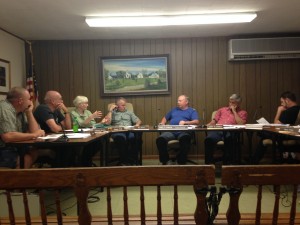Discussion over revisions to the town subdivision rules and regulations took a turn toward the hypothetical when Rochester Planning Board member Ben Bailey questioned the board’s right to dictate precisely where someone could build a house on his/her property.
The speculative scenario had to do particularly with any landowner who would want to build a house in the middle of a field, which Chairman Arnold Johnson said the board could deny if it so chose.
“I don’t know why a person with a piece of property can’t build a house [in a field],” said Bailey.
Johnson referred to a survey that Rochester residents filled out some time ago pertaining to the development of Rochester.
“They gave quite detailed answers,” said board member Susan Teal. “They wanted to see Rochester grow, but they didn’t want to have it in their faces.” She added that the trend is to build farther in the woods, out of view from the road.
“If it’s a violation of property rights, it’s a violation of property rights,” stated Bailey.
Johnson said it equates to the board simply asking the owner to submit details on the natural features on the property. When Bailey asked if there was a by-law regulating this matter, Johnson told him yes.
Bailey appeared physically appalled and called the by-law “an egregious violation of people’s property rights.”
“Personally, I think it’s a good by-law,“ Johnson said after explaining that the board regulates the placement of the structure on the lot, and the property owner must submit the plan for approval. “This town is known for its stone walls, its fields,” said Johnson.
“But you don’t pay taxes on those things,” replied Bailey.
Johnson told Bailey he would lose that argument because although the board can place restrictions on the location of the house, one could still build a house on the property.
“We’re not saying you can’t put a house on the lot,” said Johnson. “We’re not stopping them from building, Ben, there’s a difference.” Johnson continued, essentially explaining the difference between prohibiting and regulating.
Bailey thought the board’s right to decide which fields or which trees were worth saving sounded arbitrary.
“The people who want these things (protected views) aren’t the people who own this (hypothetical) property and pay the taxes on the property,” said Bailey. He likened the situation to wanting a winning lottery ticket and then taking one from another person’s pocket.
“We’re not taking anyone’s property away from them,” said Johnson. “We’re controlling how it looks.” Johnson called the by-law “a planning tool.”
“It’s just like asking them to plot wetlands,” said Johnson.
The board recommended a number of other additions and omissions to the ongoing revisions to the subdivision rules and regulations, including some items on the site plan review application.
In other matters, the board did not end up sending a letter to Shawmut Associates, Inc. regarding their dwindling escrow account and requesting them to add additional funds to cover the costs of future inspections. The day after the May 27 meeting, Shawmut Associates voluntarily sent a check to the Planning Department to cover the cost of the outstanding invoice for an engineering inspection, and Board Administrator Patrice LaForest said Shawmut Associates would also be sending another $2,250 to cover the estimated cost of one further inspection.
The two items on the agenda for Harris Real Estate Boston, LLC to rescind a Form C Subdivision Approval, and also an application for an Approval not Required, were continued until July 8 at the applicant’s request.
The next meeting of the Rochester Planning Board is June 24 at 7:00 pm in Town Hall.
By Jean Perry
